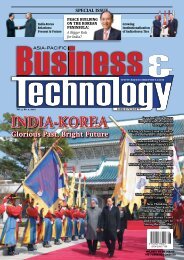Globalization of Korean Cuisine - Asia-Pacific Business and ...
Globalization of Korean Cuisine - Asia-Pacific Business and ...
Globalization of Korean Cuisine - Asia-Pacific Business and ...
You also want an ePaper? Increase the reach of your titles
YUMPU automatically turns print PDFs into web optimized ePapers that Google loves.
CoVEr<br />
STory<br />
<strong>Globalization</strong><br />
<strong>of</strong> <strong>Korean</strong> <strong>Cuisine</strong>:<br />
The Rising S<strong>of</strong>t Power <strong>of</strong> Korea<br />
By Eun young Chough<br />
Lately, the <strong>Korean</strong> food industry has been spreading<br />
its wings within the international food market.<br />
According to a research document provided<br />
by Korea’s ministry <strong>of</strong> Knowledge<br />
economy in 2008, among the 1,523 <strong>Korean</strong><br />
food-based franchise operations, 15.9 percent<br />
had opened at least one branch outside<br />
Korea. <strong>of</strong> the 15.9 percent total, fast<br />
food accounted for 24 percent <strong>and</strong> non-fast<br />
food restaurants, including traditional <strong>Korean</strong><br />
food restaurants, accounted for 12.6<br />
percent. Amongst the backdrop <strong>of</strong> these<br />
developments, the Korea Trade-investment<br />
Promotional Agency (KoTrA) <strong>and</strong> the ministry<br />
<strong>of</strong> Knowledge economy announced<br />
that they will assist ten <strong>Korean</strong> franchise<br />
companies to promote <strong>and</strong> establish their<br />
branches abroad in an attempt to increase<br />
Korea’s ‘s<strong>of</strong>t power.’ Assistance services<br />
to be provided include foreign market research,<br />
<strong>of</strong>fering legal <strong>and</strong> accounting information<br />
<strong>and</strong> finding local business partners<br />
for <strong>Korean</strong> franchise companies.<br />
many <strong>Korean</strong> food companies are considering<br />
or already entering the Chinese<br />
restaurant industry in particular, getting<br />
support from the <strong>Korean</strong> culture wave, or<br />
Hallyu, which has been spreading all across<br />
<strong>Asia</strong> <strong>and</strong> beyond. AlixPartners, a global business<br />
advisory firm, reported that Chinese<br />
consumers are spending only 22 percent <strong>of</strong><br />
their total food expenditure in restaurants,<br />
which is small in comparison to uS consumers,<br />
as revealed in a recently conducted<br />
study. However, as the total income <strong>of</strong> Chinese<br />
has been increasing, the average spending<br />
in restaurants showed an increase <strong>of</strong> 10<br />
percent in 2010. in 2009, the Chinese restaurant<br />
industry grew by about 11 percent<br />
to approximately 200 billion uS dollars, <strong>and</strong><br />
the study states that the Chinese restaurant<br />
industry will be undergoing continual increased<br />
activity in the near future.<br />
With more <strong>Korean</strong> franchise companies<br />
dipping their toes in the foreign market,<br />
Kim Soon-Jin, the Ceo <strong>of</strong> nolboo, also visions<br />
nolboo nBg as a comprehensive global<br />
restaurant corporation. Driven by her ambition,<br />
nolboo nBg emerged from the local<br />
<strong>Korean</strong> restaurant industry <strong>and</strong> entered the<br />
American <strong>and</strong> malaysian markets in 1992.<br />
nolboo nBg then entered the Chinese market<br />
via direct foreign investment.<br />
in 2006, nolboo nBg established its second<br />
corporate body in China <strong>and</strong> opened its<br />
first China branch in Beijing. in addition to<br />
China, the group also entered the Singapore<br />
market, contributing to the growing craze<br />
for <strong>Korean</strong> cuisine in these countries.<br />
“When entering a foreign market, the<br />
company needs to have a discerning eye<br />
that can look beyond long-term goals,” said<br />
Kim. “The company has to go through field<br />
CoVEr<br />
STory<br />
research <strong>and</strong> look closely into the ‘details.’<br />
if you want to gradually succeed, your business<br />
has to figure out dining habits <strong>of</strong> its future<br />
customers <strong>and</strong> their culture.”<br />
The company’s yaksun Kimchi (cabbage<br />
that has been ripened with herbs, Japanese<br />
apricots <strong>and</strong> apples) is a representative<br />
example <strong>of</strong> these endeavors. The dish<br />
received lifestyles <strong>of</strong> Health <strong>and</strong> Sustainability<br />
(loHAS) recognition in 2009, a first<br />
in the <strong>Korean</strong> food service industry. yaksun<br />
kimchi is known to contain two times more<br />
lactobacillus than both the common kimchi<br />
<strong>and</strong> yogurt. Because <strong>of</strong> its popularity<br />
in many foreign markets, yaksun Kimchi<br />
is now considered to have become a global<br />
cuisine favored by young <strong>and</strong> old, from <strong>Asia</strong><br />
to europe <strong>and</strong> the Americas.<br />
“We made changes <strong>and</strong> improved the<br />
common traditional kimchi to make it more<br />
foreigner-friendly. in hot regions, it is difficult<br />
to have or make kimchi since the salted<br />
fish ingredient attracts flies. Also, foreigners<br />
feel uncomfortable when they have red pepper<br />
between their teeth after eating kimchi.<br />
using chopsticks is another problematic<br />
issue for them.” Thus, changes were made<br />
by using red pepper blended more than the<br />
common kimchi <strong>and</strong> less salted fish.<br />
However, nolboo’s pr<strong>of</strong>iciency for success<br />
in this field was not built in a day.<br />
Twenty-four years ago, before starting her<br />
own bossam (steamed pork) <strong>Korean</strong> restaurant<br />
business, Kim went through bitter<br />
times, watching her restaurant close <strong>and</strong><br />
reopen multiple times due to low pr<strong>of</strong>it.<br />
When her earlier restaurant closed, she<br />
opened a new 15 square meter baby octopus<br />
restaurant in Shillimdong, called golmokjip.<br />
every morning, she went to the<br />
fish market, buying the freshest ingredients<br />
for customers, but still her business<br />
KIM SOON-jIN | Ceo oF nolBoo nBg (nolboo global)<br />
By eun young CHougH<br />
‘The guru <strong>of</strong> the <strong>Korean</strong> franchise business,’ or ‘A<br />
legend <strong>of</strong> success’ are examples <strong>of</strong> how people describe<br />
the Ceo <strong>of</strong> nolboo nBg, Kim Soon-Jin. From her start as<br />
an owner <strong>of</strong> a small, five square meter-sized restaurant<br />
serving bossam (meaning ‘steamed pork’ in <strong>Korean</strong>) 24<br />
years ago, Kim now oversees a total <strong>of</strong> more than 680<br />
nolboo global branches, with locations in Singapore,<br />
Beijing, <strong>and</strong> Thail<strong>and</strong>. She manages<br />
over 6,500 employees <strong>and</strong> 650 million<br />
dollars worth <strong>of</strong> sales pr<strong>of</strong>it. Kim<br />
is currently exp<strong>and</strong>ing the company<br />
throughout the world, promoting the<br />
group’s favorite menus — bossam<br />
<strong>and</strong> nolboo hangari galbi (a cuisine<br />
<strong>of</strong> short ribs marinated in a jar) —<br />
<strong>and</strong> in doing so, supporting the<br />
globalization <strong>and</strong> st<strong>and</strong>ardization<br />
<strong>of</strong> <strong>Korean</strong> cuisine.<br />
Q<br />
A &<br />
8 | A-P BuSineSS & TeCHnology rePorT A-P BuSineSS & TeCHnology rePorT | 9









